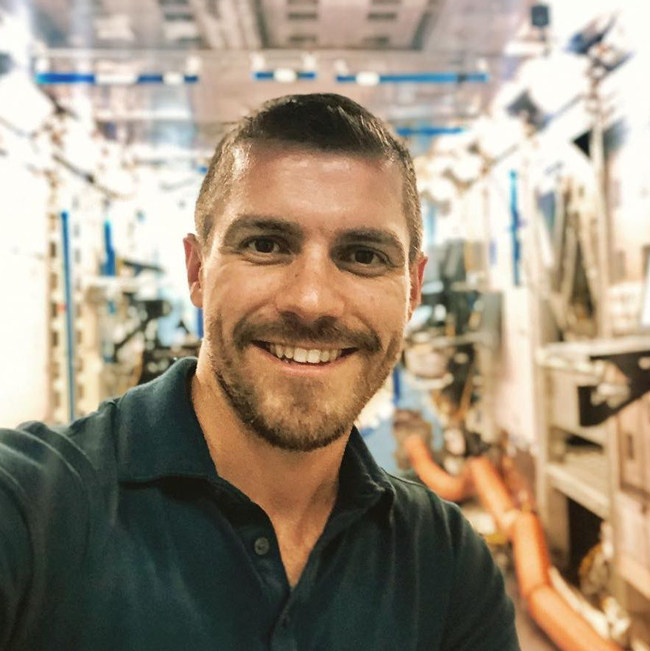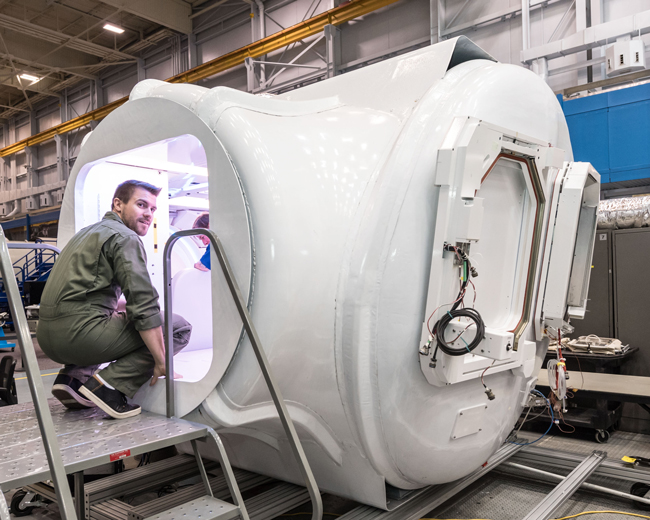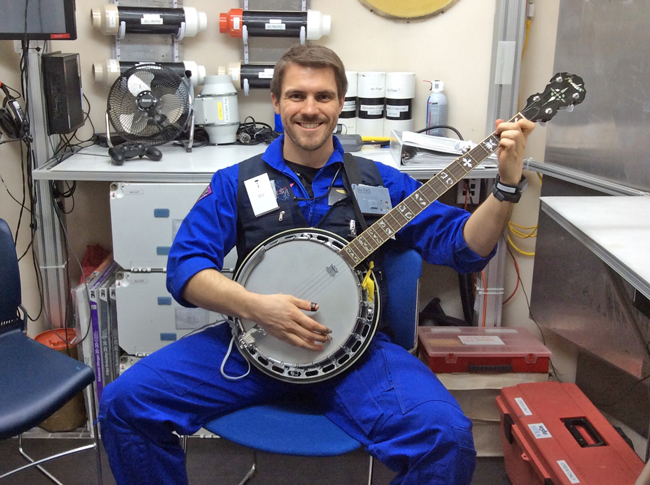Shooting for the Moon and Beyond
Kent Kalogera provides space-age fitness and LGBTQ representation at NASA.

Who among us didn’t dream of working for NASA and being an astronaut as a child? Well, openly gay International Space Station (ISS) Exercise Hardware Lead Kent Kalogera is proof that dreams can become realities. “I remember going to Kennedy Space Center as a kid, and it was the happiest place on Earth for me,” Kalogera says.
To chase his dream of being an astronaut, he started college with a concentration in aerospace engineering—before realizing that electrical engineering was more his calling. He graduated in 2008 as the economy was crashing. “At the time, my goals in life were, number one, to be an astronaut, and number two, to work in Mission Control,” Kalogera recalls. “So I applied to 51 jobs across the nation, and nobody called back. Then, due to a friend of a friend that I went to college with, I put my résumé in at Mission Control and got the job doing power systems.”
During his time at NASA, Kalogera has gotten to work on a handful of fascinating projects. He has been a Space Station flight controller, a Robonaut team member (where he performed testing on the Space Station’s humanoid robot), and now he’s engaged with the ISS department handling human health and performance. “My job is looking at how we get to the Moon and Mars from a physiological standpoint,” Kalogera explains. “How do we make sure that we humans physiologically survive when we stand on the Moon for seven days, 30 days, or [when we do] the three-year mission to Mars?”
Of course, NASA already knows what it takes to safely get humans to the lunar surface and back, but now they’re looking into what it takes to actually colonize the Moon and beyond. “When I say the word exercise, you think of what you like to do as exercise,” Kalogera adds. “But when I talk about exercise and countermeasures for the lunar surface, you have to think muscles, bones, and aerobics. You have a sensory motor [system], which is the yaw, pitch, and roll in your head [controlled by] your inner ear canals that say up, down, left and right.”

We are acclimated to gravity on Earth, so these are things that just happen for us naturally without our noticing. But in microgravity (which NASA defines as “the condition in which people or objects appear to be weightless”), these human systems get impacted. “We use the countermeasures hardware technology and new ways of exercise to counteract the effects of microgravity,” Kalogera explains.
Before you spin off into a sci-fi fantasy landscape of the imagination, note that Kalogera isn’t working with astronauts in gravity-control rooms or giant swimming pools. In actuality, Moon missions will include a microgravity resistance exercise machine called the Advanced Resistive Exercise Device (ARED). “Pneumatic pressure is used to [simulate the force of gravity] so crew members could do bench presses, squats, deadlifts, bicep curls, tricep extensions, and the gamut [of exercises] that you can do here on the ground,” Kalogera explains.
Beyond ARED, Kalogera works with NASA on exercise equipment for astronauts that includes the T2 treadmill and the Cycle Ergometer with a Vibration Isolation and Stabilization System (CEVIS). “When you’re running on a treadmill, you have the natural forces [of Earth’s gravity] that we don’t think about. When you’re up in space, it’s something you absolutely have to think about. By using springs, dampers, or dash pots, which are kind of like pneumatic air brakes, [NASA can] make sure that [things don’t start flying around] when a crew member is running or squatting.” Without this, components like the ISS solar-array wings could shift unintentionally.
In addition to his work for NASA, Kalogera recently became co-chair of Johnson Space Center’s Out & Allied Employee Resource Group, which fosters LGBTQ representation within the organization. “They’ve launched Pride flags up to ISS,” Kalogera notes. “Having that kind of representation, and a safe space to express yourself and be who you want to be, really just lets you flourish as a person.”

This Out & Allied group also helps combat the perception that NASA is a conservative place where diversity is not welcome. “If you’re spending energy to hide who you are, [that’s energy you can’t spend on] getting us to the Moon,” Kalogera emphasizes. “NASA has done a really great job at understanding that their people are their most important assets, and their people are going to be [accepted] as they are. And being LGBTQIA+ is just another expression of who you are.”
Lastly, since so many of us have New Year’s health and wellness resolutions, we asked Kalogera for three pieces of advice. “Consistency is first. You have to just show up every day, whether you feel like it or not. Put it on your timeline, put it on your calendar, and just do it,” he says. “Second, have accountability. Have someone—a friend, a family member, coworkers, the internet—keep you accountable, and then be open to them making you accountable for it.”
Kalogera’s scientific brain kicks in as he shares his final tip: “Data,” he states. “This is something that we look at quite often with our astronauts and space. We collect data on how they exercise, and the point of the data is to use it the next day or the next week [as part of an entire fitness plan]. Because if you fail to plan, you plan to fail.”
Keep up with Kent Kalogera on Instagram @kent_in_his_story.
This article appears in the January 2023 edition of OutSmart magazine.











FB Comments